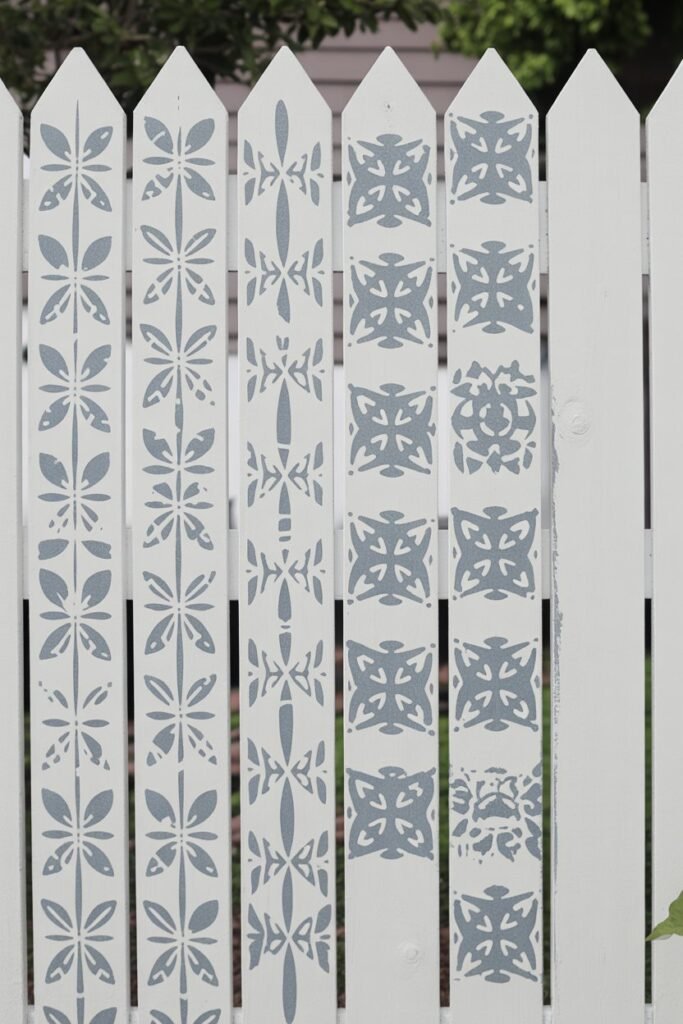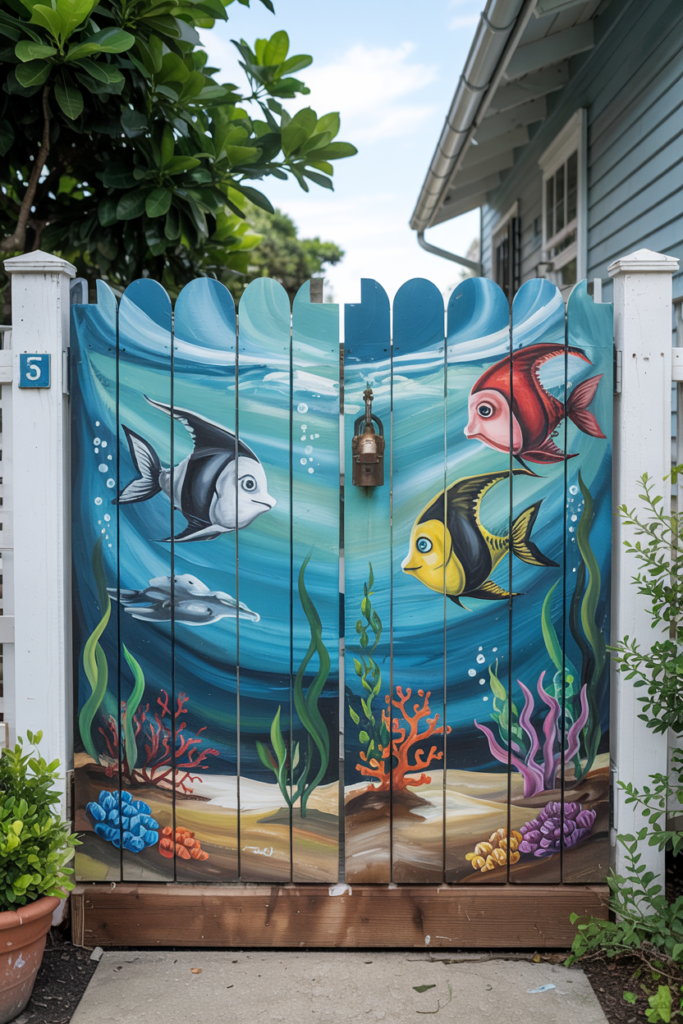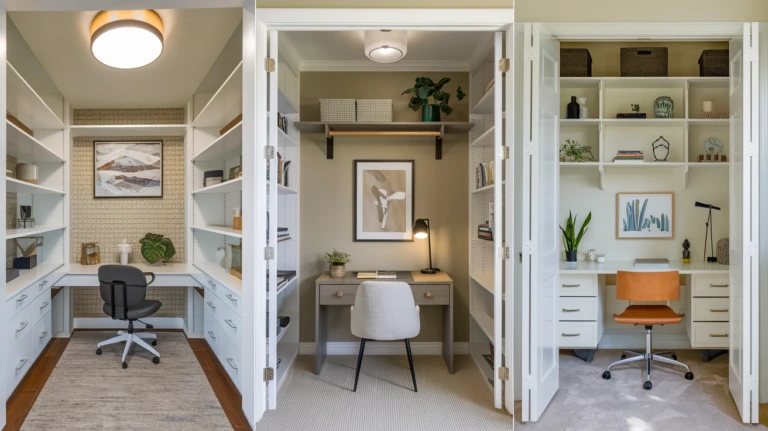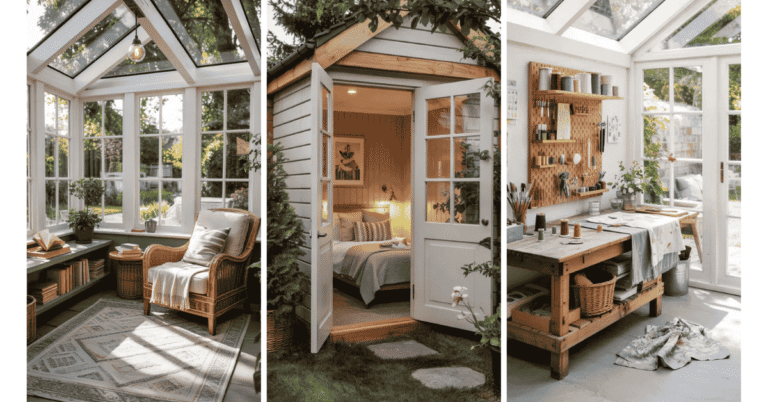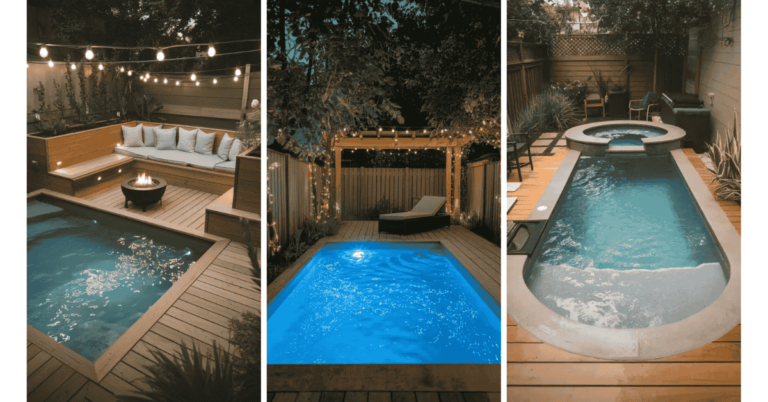20 Fence Painting Ideas to Refresh Your Outdoor Space

Fences often serve as practical boundaries, but they also offer a valuable opportunity to enhance outdoor spaces.
Painting a fence can refresh its appearance, add visual interest, and complement the surrounding landscape.
Choosing the right paint and design can transform a simple fence into a distinctive feature that adds style and personality to any yard.
Whether opting for bold colors or subtle tones, a painted fence can improve curb appeal while protecting the wood from weather damage.
20 Fence Painting Ideas
1) Bold Ombre Gradient
A bold ombre gradient uses a strong transition between colors, moving from dark at the bottom to light at the top. This creates a striking visual effect that can make a fence stand out as a key design feature in any yard.
It often combines contrasting or complementary colors to emphasize the gradient. For example, deep blues blending into bright turquoise or rich purples fading into soft pinks can produce a dynamic and artistic look.
This technique requires careful blending to ensure a smooth color transition. Using a paint sprayer or gradient stencils can help achieve a professional finish with less effort.
Bold ombre gradients work well in modern and creative outdoor spaces. They not only add depth to the fence but also bring personality and vibrancy to an otherwise plain surface.
2) Classic White with Stenciled Patterns
A classic white fence offers timeless appeal and a clean backdrop for decorative elements. When combined with stenciled patterns, it adds a subtle yet personalized touch without overwhelming the design.
Stencils allow for precise, repeatable motifs such as leaves, stars, or simple geometric shapes. These patterns can elevate the fence’s appearance by introducing texture and interest while maintaining a cohesive and elegant look.
Using outdoor acrylic paints ensures the stencil designs withstand weather conditions. Applying multiple layers with drying time between coats improves durability and vibrancy.
This approach suits those who want a refined and understated style but still appreciate detailed craftsmanship. It blends well with various garden styles and exterior colors, making it a versatile choice for many yards.
3) Sunset-Inspired Warm Tones
Sunset-inspired warm tones offer a cozy and inviting look for fences. Colors like terracotta, burnt orange, and soft reds bring a natural warmth that complements outdoor spaces. These shades work well with greens and earth tones found in gardens.
Using warm tones can create a timeless and Mediterranean flair. They also add subtle vibrancy without overwhelming the surroundings. This approach makes the fence a harmonious extension of the yard.
Paints designed for outdoor use enhance durability, preserving the color despite weather exposure. Combining warm colors with solar garden lights in similar hues boosts the fence’s visual appeal in the evening.
Overall, warm sunset colors are versatile. They suit both modern and traditional backyard styles, providing a warm backdrop that improves the atmosphere. This palette remains popular for its natural feel and lasting impact.
4) Navy Blue Accent Fence
Navy blue is a strong choice for an accent fence color. It adds a sophisticated and grounding touch to outdoor spaces without overwhelming the surroundings.
This deep hue pairs well with natural elements like plants and red brick. It creates a contrast that allows greenery to stand out while maintaining a polished look.
Navy blue works best when used on select fence panels or as a feature section. This approach highlights certain areas and adds visual interest without covering the entire fence.
Colors like crisp white, blush pink, or soft yellow complement navy blue well. These combinations soften the intensity and make the fence a balanced part of the yard’s design.
Using navy blue paint with a weather-resistant finish ensures durability and helps maintain its rich tone over time. It is a practical and visually appealing choice for those seeking a modern yet classic accent.
5) Pastel Rainbow Stripes
Pastel rainbow stripes create a soft, inviting look for any fence. Using muted shades like lavender, mint, blush, and pale yellow adds a gentle pop of color without overwhelming the outdoor space.
This style works well on wooden fences, especially when paired with proper preparation like sanding and priming. Pastel tones hold up nicely in natural light and blend easily with garden plants.
Painting stripes in evenly spaced sections gives a neat, organized pattern. This technique can brighten a yard and add personality while feeling calm and understated.
Mixing a variety of pastel colors offers versatility. It can coordinate with existing garden features or outdoor furniture, creating a cohesive and pleasant atmosphere.
Overall, pastel rainbow stripes offer a fresh, modern update for fences without being too bold or complex. It’s an accessible project for those seeking subtle enhancement with a creative touch.
6) Rustic Barn Red Finish
A rustic barn red finish brings warmth and timeless character to a fence. This classic color recalls traditional farm buildings and adds a cozy, grounded feel to outdoor spaces.
The deep red works well with natural materials like wood and stone. It creates a strong contrast while maintaining an inviting, natural appearance.
This finish suits various fence styles, especially those with a farmhouse or country aesthetic. It pairs well with greenery and can complement garden spaces or rural settings effectively.
Choosing a matte or slightly weathered paint finish enhances the rustic look. This approach avoids a glossy appearance, keeping the fence aligned with vintage charm.
Overall, the barn red finish balances bold color with traditional appeal. It is a practical choice for those wanting a striking yet familiar fence design.
7) Matte Black Modern Look
A matte black fence offers a sleek, modern aesthetic that fits well with contemporary outdoor spaces. Its non-reflective finish provides a subtle, refined appearance without drawing excessive attention.
This style works effectively for privacy fences, combining function and design. The dark color enhances surrounding greenery and bright landscaping elements through contrast.
Matte black finishes hold up well against weather conditions and require minimal maintenance. They suit various materials, including metal and wood, maintaining a timeless look.
Choosing matte black can add an element of sophistication and security. It aligns with modern design trends without overwhelming the overall property style.
8) Nautical Blue and White Combo
The nautical blue and white combination is a classic choice for fences. It evokes the calmness of the sea and adds a fresh, clean look to any outdoor space.
Using deep navy blue for the main panels with crisp white accents on trim or posts creates a balanced and structured design. This contrast helps the fence stand out without overwhelming the surroundings.
This color scheme works well for coastal homes or gardens seeking a serene feel. It pairs nicely with greenery and natural textures, enhancing the overall aesthetic.
The white picket fence is traditional, but swapping beige or standard white for a bright white with navy makes the design more modern and relevant. It reflects light and brightens the area.
This combination is versatile; it suits both modern and cottage-style landscapes. It is also practical since darker blue tones help hide dirt while the white details keep the look sharp.
9) Floral Mural with Butterflies
A floral mural combined with butterflies brings a natural and vibrant look to any fence. The design often features colorful flowers paired with delicate butterflies to create a lively outdoor scene. This style suits gardens or yards looking to add charm and visual interest.
Artists typically use bright colors like reds, yellows, and blues to highlight flowers. Butterflies add movement and depth, making the mural feel dynamic and inviting. Using weather-resistant paint ensures the artwork lasts longer outdoors.
Painting this mural on wooden or concrete fences is common. It is important to prepare the surface properly for paint to adhere well. Some choose semi-gloss finishes to enhance colors and provide a gentle sheen.
This mural style works well for DIY projects or commissioned art. It is effective in transforming plain fences into enjoyable focal points that blend with garden elements like plants and flowers.
10) Under the Sea Themed Painting
An under the sea theme brings vibrant color and life to any fence. It allows for creative inclusion of marine elements like coral reefs, ocean fish, and underwater plants. This style works well for those who enjoy marine life or want a calming, nature-inspired outdoor space.
The painting can range from simple wave patterns to detailed scenes with fish, mermaids, or seabirds. Using bright blues, greens, and splashes of coral colors helps capture the underwater atmosphere. It also provides opportunities to experiment with acrylic paints and layering techniques.
This theme suits both small fence sections and entire fences, depending on the desired impact. It can also complement garden spaces with a coastal or tropical vibe. The style is versatile, offering room for personal expression while maintaining a natural, peaceful look.
11) Geometric Color Blocking
Geometric color blocking is a popular technique that creates bold, clean lines on a fence using contrasting colors. It adds a modern, artistic touch without overwhelming the space.
This style works well with triangles, rectangles, or irregular shapes. The use of sharp edges and distinct color zones helps define the structure and adds visual interest.
Choosing complementary or contrasting colors enhances the effect. Neutral tones combined with bright accents can balance vibrancy and subtlety.
Preparation is important. Clear surface cleaning and precise taping ensure the geometric shapes look sharp and professional.
This method suits various fence materials, including wood and vinyl. It refreshes old fences quickly and can be completed over a weekend.
Geometric color blocking transforms plain boundaries into standout features by combining design and color thoughtfully. It fits both small urban yards and larger garden spaces.
12) Natural Wood Stain with Color Highlights
This fence painting idea combines the warmth of a natural wood stain with subtle color accents to create depth and interest. The base stain preserves the wood’s natural grain and texture, offering protection against moisture and sun damage.
Color highlights can be applied to specific sections such as rails or posts. These accents add contrast without overpowering the wood’s natural look. The technique allows the fence to blend naturally with landscaping while introducing a unique visual element.
Choosing semi-transparent or transparent stains allows the wood’s character to remain visible. The color highlights typically use solid or semi-opaque paint to create clear but restrained emphasis.
This approach balances durability and design, making it suitable for those who want a traditional appearance with a modern twist. It can work well with a variety of wood types and outdoor styles.
13) Two-Tone Horizontal Stripes
Two-tone horizontal stripes provide a clean, modern appearance that enhances the visual appeal of a fence. This pattern typically pairs complementary colors such as navy blue with cream or charcoal with white to create subtle yet effective contrast.
The horizontal lines help elongate the fence’s appearance, making the space feel wider. This design choice adds architectural interest without overwhelming the area.
Using contrasting colors between the top and bottom or alternating stripes can emphasize the structure. It works well with various fence materials, including wood and composite.
This style balances simplicity and sophistication, suitable for both traditional and contemporary settings. It can update an ordinary fence into a distinct feature of the outdoor space.
14) Vibrant Turquoise with Yellow Accents
Painting a fence in vibrant turquoise creates a lively and fresh atmosphere. This color evokes a coastal feel, bringing a sense of calm and energy to outdoor spaces.
Adding yellow accents enhances this look by introducing brightness and warmth. Yellow highlights on edges or select panels complement the turquoise while drawing attention to the fence’s structure.
This combination works well with neutral surroundings, such as white or natural wood elements. It adds interest without overwhelming the overall landscape.
The turquoise base serves as a strong, soothing backdrop. The yellow accents provide contrast, making the fence visually striking and well-balanced.
Together, these colors create an outdoor feature that is both modern and inviting. They suit a variety of garden styles, from contemporary to tropical-inspired.
15) Soft Gray with White Trim
Soft gray paired with white trim creates a timeless and elegant look for fences. This combination enhances the architectural details and adds subtle contrast without overpowering the surrounding landscape.
The gray serves as a neutral base that blends well with various exterior house colors. White trim highlights edges and rails, giving the fence a polished and defined appearance.
This color scheme suits both traditional and modern homes. It offers versatility, working well with wood, vinyl, or metal fences.
Soft gray with white trim can also complement a wider range of garden colors and textures. It provides a clean backdrop that allows plants and flowers to stand out.
Maintaining this look requires occasional touch-ups since white trim can show dirt more easily. However, the fresh and structured effect usually justifies the upkeep.
16) Bold Primary Colors for Kids’ Areas
Using bold primary colors like red, blue, and yellow on fences near kids’ play areas creates a lively and engaging environment. These colors are visually stimulating and can help define the space clearly.
Bright primary hues also encourage creativity and fun. Painting a fence in these tones can make the yard feel more welcoming and energetic for children.
Primary colors are easy to pair with playful patterns or simple shapes. This allows for customization without overwhelming the space.
Choosing durable, weather-resistant paint is important to maintain vibrancy despite outdoor exposure. Regular touch-ups will keep the colors looking fresh over time.
This approach works well in family-friendly yards where safety and visual appeal are both priorities. The bold colors also make it easier for parents to keep an eye on kids while they play.
17) Distressed Paint for Vintage Charm
Distressed paint is a popular technique to give fences a vintage, weathered appearance. It involves layering paint and then sanding parts of the surface to reveal the underlying wood or previous colors. This creates a naturally aged look without appearing artificial.
The process usually starts with a base coat followed by a white or light-colored topcoat. Strategic sanding exposes patches of the base layer and wood grain. The outcome is a shabby chic style that adds character and rustic charm.
This technique works well on wooden fences, especially those with some wear or texture. It can complement various outdoor styles, from cottage gardens to farmhouse yards. The distressed finish gives the fence a subtle yet distinct visual interest.
Using matte or chalk paint is often preferred for this effect as it wears down more easily. Protective sealing can be added to maintain durability while preserving the aged look. Distressed painting is a cost-effective way to refresh old fencing without full replacement.
18) Bright Yellow Statement Fence
A bright yellow fence creates an immediate visual impact in any outdoor space. It adds vibrancy without overwhelming, offering a cheerful and inviting atmosphere.
This color works well in gardens or yards where natural greens dominate, providing a sunny contrast that enhances surrounding plants. Yellow also pairs effectively with neutral or earth tones on other landscape elements.
Using a bold yellow shade turns the fence into a focal point. It can define boundaries while giving the yard a modern and uplifting appearance. Proper paint selection ensures durability and color retention, especially in exposed areas.
A bright yellow fence suits both residential and commercial properties aiming for a fresh, contemporary look. Maintenance involves regular cleaning and occasional touch-ups to preserve its intensity over time.
19) Minimalist Solid Neutral Color
A minimalist solid neutral color offers a clean and timeless look for any fence. Shades like soft gray, beige, or warm taupe blend seamlessly with natural surroundings.
This choice enhances curb appeal without overpowering other elements in the yard. It creates a calm and understated backdrop that suits modern and traditional styles alike.
Neutral tones also require less frequent touch-ups because they hide dirt and wear better than bright colors. This makes them practical as well as stylish for outdoor use.
Using a matte or satin finish can add subtle texture while maintaining simplicity. This approach highlights the fence’s structure rather than distracting from it.
Overall, a solid neutral color supports a balanced and cohesive outdoor space. It helps the fence complement plants, furniture, and architecture instead of competing for attention.
20) Dark Green for Garden Blend
Dark green is a practical choice for garden fences. It helps the fence blend naturally with plants and foliage, creating a seamless transition between the garden and its boundary.
This color works well in woodland or natural settings, offering a subtle backdrop without overpowering flowers or other garden features. It also maintains its appearance through different seasons, staying visually appealing year-round.
Choosing a dark green with gray undertones can add a sophisticated touch. It avoids being too bright while giving the fence an earthy, calming presence.
This shade is especially effective for those who want their fence to complement rather than compete with the surrounding greenery. It enhances the overall harmony of the outdoor space without drawing unnecessary attention.
Planning Your Fence Painting Project
Successful fence painting depends on selecting the appropriate paint, preparing the fence surface thoroughly, and having the right tools at hand. These steps ensure a durable finish and enhance the fence’s appearance while minimizing future maintenance.
Choosing the Right Paint Type
Selecting the correct paint is crucial for durability and appearance. For wooden fences, oil-based or exterior latex paint offers good protection against weather damage. Oil-based paint provides a hard, durable coat but takes longer to dry, while latex dries faster and is easier to clean.
Metal fences require rust-inhibiting primers and specially formulated metal paints to prevent corrosion. Vinyl fences benefit from flexible exterior paint designed to adhere to smooth, non-porous surfaces.
Always choose exterior-grade paints with UV resistance and waterproof qualities. Consider finish types: satin or semi-gloss finishes repel dirt and moisture better than flat finishes, which may fade faster.
Preparing Your Fence Surface
Thorough preparation improves paint adhesion and longevity. It begins with cleaning the fence using a pressure washer or scrubbing with detergent to remove dirt, mold, and loose paint. Allow the fence to dry completely before proceeding.
Next, sanding smooths rough spots and removes peeling paint. Damaged or rotten wood sections should be repaired or replaced for a uniform surface.
Applying a primer suited to the fence material helps seal pores and creates a binding layer for paint. Priming is especially important for bare wood, metal, or previously unpainted fences.
Essential Tools for Painting
Having the right tools simplifies the job and ensures professional results. Basic essentials include:
- Paintbrushes: Use angled synthetic brushes for edges and detailed work, and wide brushes or rollers for large panels.
- Paint roller: A medium-pile roller covers flat surfaces evenly.
- Paint tray: Holds paint conveniently for rollers and brushes.
- Drop cloths: Protect the ground and nearby plants from paint splatters.
- Painter’s tape: Helps achieve clean edges around posts or decorative elements.
Other useful items include ladders for tall fences, sanding blocks, and gloves for protection. Organizing all tools before starting saves time during the project.
Maintenance and Longevity
Proper upkeep extends the life of painted fences and maintains their appearance. Protecting fences from environmental damage and performing timely repairs are critical steps to ensure durability and avoid costly replacements.
Protecting Painted Fences from Weather
Fences face constant exposure to sun, rain, humidity, and temperature changes. To guard against these, it is essential to use high-quality, weather-resistant paint with UV protection and mildew inhibitors. Applying a clear sealant after painting adds an extra barrier against moisture and fading.
Regular cleaning removes dirt, mildew, and debris that can degrade paint and encourage wood rot. Avoid using harsh chemicals; instead, use mild soap and water. Checking for drainage issues around the fence line can prevent water pooling, which accelerates damage.
Wood fences typically require repainting every 2 to 3 years, while metal and vinyl fences may last 5 to 10 years with less frequent maintenance. Choosing paints designed for outdoor use and reapplying finishes seasonally extends protection.
Touch-Up and Repair Tips
Small scratches, chips, or peeling should be addressed promptly to prevent further deterioration. Lightly sand damaged areas before applying matching paint to improve adhesion. For wood fences, inspect for signs of rot or insect damage and replace affected boards as needed.
Regular inspections can catch problems early. Maintaining a small supply of the original paint color simplifies touch-ups. Use a brush instead of a roller for precision on small spots.
If the fence shows widespread peeling or fading, consider a full repaint. Proper surface preparation, including cleaning and sanding, ensures new paint bonds well. Using primer on bare or heavily worn surfaces strengthens durability and adhesion.


